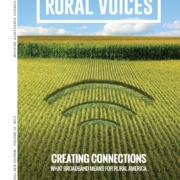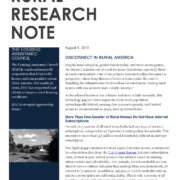HAC News: April 19, 2019
News Formats. pdf
April 19, 2019
Vol. 48, No. 8
Appropriators express support for rural housing • National Endowment for the Arts taps HAC for the Citizens’ Institute on Rural Design • New funding available • HUD asks for input on maximizing Opportunity Zones’ benefits • Comments from tribes requested on Section 184 regulation changes • Rural needs noted at Community Reinvestment Act hearing • House committee approves the Ending Homelessness Act • Housing Week of Action scheduled May 30-June 5 • National poll shows strong support for federal action on affordable housing • Hearing spotlight continues on rural housing affordability • RuralSTAT • Recent publications of interest • HAC offers Section 502 packaging training for nonprofits in May • Need capital for your affordable housing project?
HAC News Formats. pdf
April 19, 2019
Vol. 48, No. 8
Appropriators express support for rural housing.
USDA Secretary Sonny Perdue appeared before the House agriculture appropriations subcommittee on April 9 and the Senate subcommittee on April 11 to defend the Administration’s budget request. Responding to a question from Sen. Jeff Merkley (D-OR), Perdue said he could not disagree on the importance of the rural housing programs, but suggested the Administration may have proposed no funding for most of them because it thought they could be moved to HUD – something not mentioned in the budget documents. Sen. Merkley and Rep. Sanford Bishop (D-GA) both opposed the proposed move of ERS and NIFA. Legislators from both parties spoke in favor of improving rural broadband service.
National Endowment for the Arts taps HAC for the Citizens’ Institute on Rural Design.
The NEA has selected HAC, along with buildingcommunityWORKSHOP, to carry out the Citizens’ Institute on Rural Design. With the HAC partnership, CIRD will maintain competitive funding for small and tribal communities to host multi-day design workshops, helping to turn good ideas into reality. CIRD will reach up to 20 additional communities with peer learning and design-rooted capacity building, coupled with support for navigating funding opportunities. In late May CIRD will release a Request for Applications, inviting communities to apply for the program. Join CIRD’s mailing list here. HAC CEO David Lipsetz shared his thoughts on the new initiative.
New funding available
- USDA’s ReConnect Program will fund state and local governments, tribes, nonprofits, for-profits, limited liability companies and coops to provide broadband infrastructure in rural areas with populations under 20,000. Applications are due May 31 for grants, June 21 for loan/grant combinations and July 12 for loans.
- Rural Cooperative Development Grants will be made to nonprofits and public or private institutions of higher education to help individuals and businesses start, expand or improve rural cooperatives and other mutually owned businesses. Apply by June 3.
- Choice Neighborhoods Planning Grants or Planning and Action Grants are available to nonprofits, PHAs, local governments and tribal entities in communities with severely distressed public or HUD-assisted housing. Apply by June 10.
- Family Self-Sufficiency grants are offered for PHAs that did not receive FY16, FY17 or FY18 FSS grants. Applications are due June 13.
HUD asks for input on maximizing Opportunity Zones’ benefits.
HUD seeks recommendations on actions it can take to encourage public and private investment “in urban and economically distressed communities, including qualified Opportunity Zones.” Comments are due June 17, 2019. For more information, contact Daniel Marcin, HUD, 202-402-2967.
Comments from tribes requested on Section 184 regulation changes.
HUD has drafted changes to the regulation governing the Section 184 Indian Home Loan Guarantee program and seeks comments from tribes by June 3. The proposed rule will be published later in the Federal Register for general comment. For more information, contact HUD staff.
Rural needs noted at Community Reinvestment Act hearing.
On April 9, the House Financial Services’ Subcommittee on Consumer Protection and Financial Institutions held a hearing entitled “The Community Reinvestment Act: Assessing the Law’s Impact on Discrimination and Redlining.” The hearing focused on how CRA could better reach underserved communities, and rural members like Reps. Scott Tipton (R-CO) and David Kustoff (R-TN) brought up the importance of making sure CRA works well for rural America. Some of the experts testifying at the hearing also specifically highlighted rural CRA needs.
House committee approves the Ending Homelessness Act.
On March 28 the House Financial Services Committee approved H.R. 1856, which would provide $13.27 billion in new funding over five years for new affordable housing units, new vouchers, case management and technical assistance. There is currently no companion bill in the Senate.
Housing Week of Action scheduled May 30-June 5.
The National Low Income Housing Coalition offers online guides for how to plan activities such as rallies, press events, teach-ins, meetings with elected officials and letter-writing campaigns, as well as sample materials and content including talking points, tweets, op-eds, press releases, social media images and posters.
National poll shows strong support for federal action on affordable housing.
A recent poll commissioned by the Opportunity Starts at Home campaign through Hart Research Associates found 85% of respondents believe that ensuring everyone has a safe, decent, affordable place to live should be a top national priority. Almost as many (83%) agree that elected officials are not paying enough attention to affordable housing needs. Seventy percent of city dwellers, as well as 59% of suburbanites and 53% of rural residents, say housing affordability is a problem in their area.
Hearing spotlight continues on rural housing affordability.
Continuing a theme from testimony in front of the House subcommittee on Housing, Community Development and Insurance, HAC discussed the issue of an affordability crisis in rural housing with various media outlets. HAC’s research director Lance George spoke with CBS News about Housing’s hidden crisis: Rural Americans struggle to pay rent. Additionally, CEO David Lipsetz sat for an interview with Newsy to elaborate on the characteristics of the crisis and highlight possible solutions.
RuralSTAT. An estimated 20% of homes in rural and small town areas are vacant – which is nearly twice the vacancy rate for suburban and urban communities. For more information on housing vacancy in your community, visit HAC’s Rural Data Portal.
Recent publications of interest
- 2019 Advocates’ Guide: A Primer on Federal Affordable Housing & Community Development Programs is the National Low Income Housing Coalition’s annual update of its overview of programs and policy tools.
- 2019 County Health Rankings & Roadmaps, released by the Robert Woods Johnson Foundation, focuses on the link between housing and health at the county level, finding that severe housing cost burden affects health. The report website allows researchers to explore how healthy different counties are and to review policy solutions including mixed use development and legal support for tenants in eviction hearings.
- USDA’s Census of Agriculture, conducted every five years, presents numerous indicators for U.S. farms and farm producers. The data from 2017 indicated that the number of overall farms declined by 3.2 percent from 2012, and the median age of farm producers increased to 57.5 years.
- Any Federal Infrastructure Package Should Boost Investment in Low-Income Communities, published by the Center on Budget and Policy Priorities, details the needs of low-income communities that could be addressed through a federal infrastructure package, including affordable housing for low-income families, seniors and people with disabilities.
- Dying Too Soon: County-level Disparities in Premature Death by Rurality, Race, and Ethnicity, a brief from the University of Minnesota Rural Health Research Center, reports that the highest rates of premature death were observed in counties where a majority of residents were non-Hispanic Black or American Indian/Alaskan Native. For all racial/ethnic groups (except American Indian/Alaskan Native, for which comparison data was lacking), premature deaths were significantly higher in rural counties than urban ones.
- The Gap: A Shortage of Affordable Homes, from the National Low Income Housing Coalition, reports that only 37 affordable and available homes exist for every 100 extremely low-income renter households nationwide and there is a shortage in every state.
- Paycheck to Paycheck, by the National Housing Conference, offers a report and database with information on housing affordability for working households.
- The State of Homelessness in America, issued by the National Alliance to End Homelessness, reviews data at the national and state levels to show trends in homelessness, homeless assistance and at-risk populations.
HAC offers Section 502 packaging training for nonprofits in May.
This three-day advanced course trains experienced participants to assist potential borrowers and work with RD staff, other nonprofits, and regional intermediaries to deliver successful Section 502 loan packages. The training will be held May 7-9 in Kansas City, MO. For more information, contact HAC staff, 404-892-4824.
Need capital for your affordable housing project?
HAC’s loan funds provide low interest rate loans to support single- and multifamily affordable housing projects for low-income rural residents throughout the U.S. and territories. Capital is available for all types of affordable and mixed-income housing projects, including preservation, farmworker, senior and veteran housing. HAC loan funds can be used for pre-development, site acquisition, site development and construction/rehabilitation. Contact HAC’s loan fund staff at hacloanfund@ruralhome.org, 202-842-8600.
Please note: HAC is not able to offer loans to individuals or families. Borrowers must be nonprofit or for-profit organizations or government entities (including tribes).





 households, compared to 6 percent of metropolitan area households use satellite internet services. Greater isolation and more sparse populations in rural areas likely explain the more common use of satellite technology, where cable or fiber optic services are not available.
households, compared to 6 percent of metropolitan area households use satellite internet services. Greater isolation and more sparse populations in rural areas likely explain the more common use of satellite technology, where cable or fiber optic services are not available.